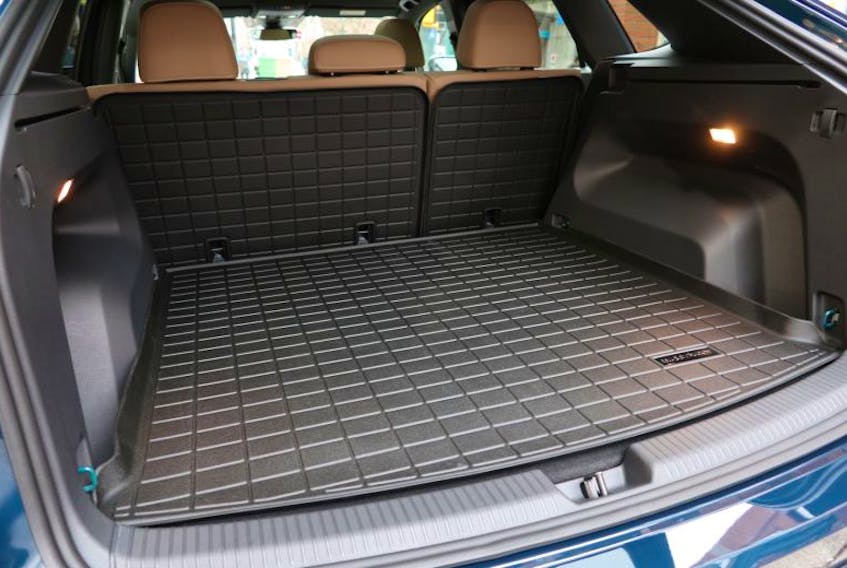JIL MCINTOSH
WHISTLER, B.C. — When they launch a new vehicle, most automakers make an impression by offering customers more.
But Volkswagen’s deal with its Atlas Cross Sport is to take its largest SUV, and then give us less — a bit less bulk, and most noticeably, two fewer seating positions.
All-new for 2020, the Cross Sport is built off the three-row Atlas sport-ute. The wheelbase stays the same, but the body is 144 millimetres shorter thanks to shaved-off front and rear overhangs. The roof comes down by 59 mm and ends in handsome “sportback” styling. There are new design cues, such as the three-bar grille design and fascias, that will be reverse-engineered to the Atlas for its 2021 refresh. And while the Atlas has three rows of seats, the Cross Sport has two.
On the surface, the paring-down seems relatively minor — don’t many three-row SUV owners simply fold down those rear ones most of the time, anyway? — but it appears there’s a method to Volkswagen’s madness. It’s tempting to think of the SUV market as a single bloc, but there are all kinds of subsections, and like other automakers, Volkswagen tracks it obsessively.

The Atlas gave Volkswagen a considerable number of new customers — 88 per cent of buyers hadn’t bought a VW before — and are also among the youngest in the segment. But more than half of intermediate sport-ute buyers opt for five-seater models, many of them empty-nesters who no longer need the extra chairs. With SUVs alone making up almost half of all Canadian sales, VW figures it’s worth the trouble to woo buyers for whom an Atlas offers a bit more than they need.
Along with the wheelbase, the Atlas Cross Sport shares its two engines with its bigger brother. The base unit is a 2.0-litre turbocharged four-cylinder, making 235 horsepower and 258 pound-feet of torque. The upgrade is a 3.6L V6 churning out 276 horsepower and 266 lb.-ft. of torque. Both engines mate to an eight-speed automatic, and both come strictly with VW’s 4Motion all-wheel-drive system and selectable drive modes, including Snow and Off-road settings. Currently, VW only pairs the turbo-four with front-wheel-drive on the Atlas, but Canadians overwhelmingly like their sport-utes with four-wheel traction. When the refreshed, three-row 2021 Atlas arrives, then like the Cross Sport, it’ll be AWD-only for both engines
The Cross Sport starts out in Trendline trim with the four-cylinder, starting at $38,995. The mid-range Comfortline offers the four-cylinder for $45,195, or $47,395 for the V6. The top-spec Execline is V6-only, at $54,495. For an additional $1,690, the Atlas Cross Sport Execline can be optioned with the R-Line package, adding 21-inch wheels, sportier styling, a unique steering wheel, and stainless-steel pedals.
I drove both engines from Vancouver to Whistler, on the curvy and scenic Sea to Sky Highway. They both get the job done, but each has its own style of getting there. You’ll have to weigh your preference against the price, as well as the fuel economy — a combined city/highway rating of 11.7 L/100 kilometres for the four-cylinder, versus 12.7 for the V6.

The V6 naturally feels more powerful, although putting your foot down gives you smooth and linear acceleration, rather than a push back in your seat. That’s not a criticism: this is luxury liner, not sporting machine, and its performance is right in line with how I think it should feel. The throttle response is immediate, and there’s plenty of power for passing.
In contrast, when you press the pedal moderately on the four-cylinder Cross Sport, there’s a bit of a dead spot before anything happens. Acceleration is more tepid than with the V6, of course, and the transmission downshifted more than the V6 on uphill grades. But in its favour, the four-cylinder Cross Sport seems much lighter and more agile. Neither drives as big as it actually is, but I preferred the four-cylinder’s steering feel and response. I’d suggest test-driving them both to see which characteristics appeal to you more.
The cabin is quiet and well-designed, with simple controls — as they always should be. The entry-level Trendline is equipped rain-sensing wipers, an auto-dimming rear-view mirror, blind-spot monitoring, and full LED exterior lighting, among other bits. Upper trims add such features as a power liftgate, a panoramic sunroof, ventilated front seats, heated rear seats, a heated steering wheel, a Fender premium audio system, and Traffic Jam Assist, which combines adaptive cruise control and lane centering into a semi-automated system for stop-and-go driving situations.
German automakers tend to be very good at making seats, and that’s the case with the Atlas Cross Sport. They’re very supportive and comfortable, both in the front and rear. Those in the second row get an almost ridiculous amount of legroom, while the cargo compartment gives you up to 1,141 litres of space. If that’s not enough, the second row folds flat. To be fair, the Cross Sport’s styling steals a bit of headroom versus what the three-row Atlas provides, but it’s still generous. However, it also results in a smaller and sharply raked rear window, which cuts into rearward visibility. Take advantage of the back-up camera (now standard on all new vehicles) when you’re backing up.
While it’s slightly smaller than the three-row Atlas, the Cross Sport is still big. It’s for those who want a lot of interior space and don’t want to sacrifice any of it to an extra set of chairs. And on top of it, it’s a really good-looking beast. In the crowded SUV segment, I think it’s going to stand out.
Copyright PostMedia Network, 2020









